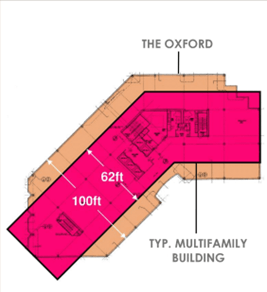This Guest Article for REVITALIZATION is by Fernando Bonilla-Verdesoto.
On October 27, 2023, the Biden administration released a guidebook outlining how the federal government can assist in office to residential conversions.
In recent years, the need for additional housing has escalated just as the rise of work-from-home and hybrid work models.
Post-pandemic office leasing has slowed significantly while hundreds of office buildings across the country, mostly Class B and C buildings, are left vacant.
This has made the topic of office-to-residential conversions an important conversation for cities across the country. According to a recent report, Washington, DC is at the forefront of those conversions.
There are some key points that need to be considered when contemplating an office to apartment building transformation, and an architects’ perspective is at the forefront of those initial considerations.
1) Investigate existing conditions
The first step is to document as much information about the building as possible. Original floor plans are ideal, but anything that provides clues about how the building is structured will be helpful.
Do your due diligence by collaborating with existing building engineers, ownership and management to dig into the building’s history and understand any and all potential structural issues that could occur down the road.
The more you anticipate what is to come, the better you can plan and proactive problem-solve before the conversion.
2) Maximize Rentable Square Footage
This might seem obvious, but given the very different floorplates between office and residential buildings, you have to get very creative when formulating the layout of a living space.
For example, a typical apartment building has a 65-foot deep floorplate, while an office building can be as 200 feet deep.
That extra space will need to be conceptualized either by creating an interior courtyard, which can prove very costly and time consuming, or by creating deeper units which can challenge the ability to achieve natural light within the living spaces.
3) Integrate New MEP Systems Efficiently
 Integrating the mechanical, electrical and plumbing engineering (MEP) systems in a strategic and efficient way in a potentially centuries-old office building is arguably the most challenging aspect of any conversion project.
Integrating the mechanical, electrical and plumbing engineering (MEP) systems in a strategic and efficient way in a potentially centuries-old office building is arguably the most challenging aspect of any conversion project.
For example, in one particular conversion at The Oxford in Maryland, an entire elevator shaft was converted to a pathway for HVAC to ensure fresh air was directed to the apartments.
Carving out additional space is often necessary to accomplish the level of customization required for individual units to be provided with the HVAC demands found in homes.
4) Creative Solutions to Enhance Curb Appeal
There is a clear and distinct difference between the entryway of a welcoming apartment building and a formal lobby of a corporate office building.
In order to transform an office entryway to be ready to welcome residents into their new home, one must adapt and include textures, finishes and landscaping to achieve a residential feel.
Adding natural elements like wood can soften the feel of metal. Creating a walkway with landscaping and hardscaping more typically found in a neighborhood can also create a more gentle, residential appeal.
5) Thoughtful Amenities and Common Areas
Older office buildings lack the amenities found in brand new apartment buildings like state-of-the-art fitness centers, dog spas, mail and package centers, workspaces, common areas and game rooms. Apartment-style living has come a long way!
When adapting an older office building to a modern living space, these amenities are critical in bringing that living space up to par.
Deep floor plates, which as mentioned are a challenge when designing units, are helpful when planning for dynamic common areas because there is more expansive space to create inviting environments for residents.
Innovative use of a typical large office lobby space can be a way to incorporate some of these highly-sought after resident add-ons.
In Conclusion
Converting aging office buildings into residential spaces can present significant challenges, but it is an intriguing and viable option to repurpose these underutilized structures.
Aside from what is outlined above, navigating zoning regulations, addressing structural limitations, there are various hurdles to overcome. However, the potential benefits of transforming these spaces into vibrant living environments, contributing to urban revitalization, and addressing housing shortages make it a worthwhile endeavor.
By embracing innovative design solutions and leveraging the existing infrastructure, the conversion process can breathe new life into sleepy city centers and aging office buildings by offering both a sustainable solution and an opportunity to create unique communities.
Ultimately, the challenges of converting offices to residential are outweighed by the exciting possibilities it presents for transforming cities and improving the quality of urban living.
For those willing to roll up their sleeves and deal with what comes with the territory, there are distinct benefits to be had.
No matter how you look at it, office to residential conversions are an exciting puzzle to solve and have the potential to be one of the next trends of housing offered during a time when the need for housing, particularly affordable housing, is at an all time high.
About the Author:
 Fernando Bonilla-Verdesoto is the Principal and Founder of Soto Architecture & Urban Design, PLLC, which is based in Washington, DC.
Fernando Bonilla-Verdesoto is the Principal and Founder of Soto Architecture & Urban Design, PLLC, which is based in Washington, DC.
With more than 20 years of experience in design, documentation and construction administration of urban developments, his expertise includes new construction and renovations of mixed-use, multifamily, senior living, student residences, assisted living communities and office to residential conversions.
Fernando is a board member of MiCasa, a non-profit affordable housing developer committed to providing quality affordable housing in the Washington, DC area, he is a fellow of the ULI Leadership Program and a frequent Guest Speaker and Juror at the University of Maryland, George Washington, and Catholic Universities. (email Fernando)

